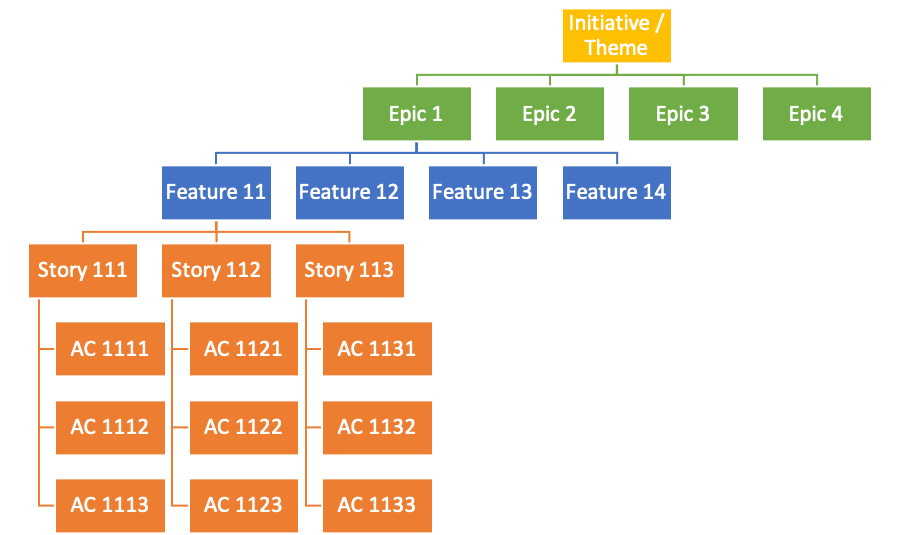Confused Between Theme, Epic, Story, and Acceptance Criteria?
As a business analyst, these terms must have been hurled at you rapidly when your project follows an agile-based development approach. Although, intuitively, some of these terms may make sense to you, establishing a clear relationship is often challenging.
Let’s try to understand all these terms with a worked-out example.
Initiatives are projects taken up to achieve a specific business objective. Typically, each initiative shall contain multiple epics that drive toward a common goal. In our example, the initiative is Creating a Mobile Learning app.
Epics are large bodies of work derived from the initiative objectives. Epics can be broken down into several Features. In our example initiative, the following ones are identified epics.
1.1 (Epic) Login
1.2 (Epic) View Courses
1.3 (Epic) Buy courses
1.4 (Epic) Dashboard
1.5 (Epic) Study guide
1.6 (Epic) Quizzes
1.7 (Epic) Learning videos
1.8 (Epic) Flashcards
Features are key functionalities provided by the epic. Features are further divided into multiple stories.
For the Epic Login, the following are key features identified:
- 1.1.1 (Feature) New user login
- 1.1.2 (Feature) Existing user login
- 1.1.3 (Feature) Forgot password
- 1.1.4 (Feature) Login through social media
Stories, also called “user stories,” are short requirements or requests written from an end user's perspective. The development team creates tasks to implement stories.
Acceptance criteria define specific expectations, such implementation of business rules for each story.
Test cases follow acceptance criteria.
In the following example, we developed a few stories for Epic – Login.
- (Theme/Initiative) Mobile app for SuXeed LMS
- 1.1 (Epic) Login
- 1.1.1 (Feature) New user login
- 1.1.1.1 (Story) As a new user, I should be able to register in order to use the LMS.
- 1.1.1.1.1 (Acceptance criteria) Username must be a valid unique email.
- 1.1.1.1.2 (Acceptance criteria) Password must follow org. password policy.
- 1.1.1.1.3 (Acceptance criteria) Password must not be displayed when the user enters the same.
- 1.1.1.1.4 (Acceptance criteria) System must alert when an exiting email id used for creating new account.
- 1.1.2 (Feature) Existing user login
- 1.1.2.1 (User Story) As a registered user, I should be able to login to the LMS in order to use the LMS.
- 1.1.2.1.1 (Acceptance criteria) Username must be a valid email and password must be valid.
- 1.1.2.1.2 (Acceptance criteria) Password must not be displayed when the user enters the same.
- 1.1.2.1.3 (Acceptance criteria) After 3 unsuccessful attempts, the system shall lock the account to protect against unauthorized access.
- 1.1.2.1.4 (Acceptance criteria) When the password entered is system generated, the system shall ask for a new password. The new password must be doubly confirmed.
- 1.1.3 (Feature) Forgot password
- 1.1.3.1 (User Story) As a registered user, I should be able to retrieve my password when I forget the same.
- 1.1.3.1.1 (Acceptance criteria) The system shall reset the password to a random password and send the one-time password to the registered email id.
- 1.1.4 (Feature) Login through social media
- 1.1.4.1 (User Story) As a new user, I should be able to sign-up for the LMS in order to use the LMS.
- 1.1.4.1.1 (Acceptance criteria) The system shall allow new user registration through LinkedIn, Google, and Facebook profiles.
- 1.1.4.1.2 (Acceptance criteria) The system shall alert and not allow new user registration through LinkedIn, Google, and Facebook profiles when such a profile exists in the system.
- 1.1.4.2 (User Story) As a new/registered user, I should be able to login to the LMS in order to use the LMS.
- 1.1.4.2.1 (Acceptance criteria) The system shall allow existing users to log in through LinkedIn, Google, and Facebook profiles.
- 1.1.4.1 (User Story) As a new user, I should be able to sign-up for the LMS in order to use the LMS.
- 1.1.3.1 (User Story) As a registered user, I should be able to retrieve my password when I forget the same.
- 1.1.2.1 (User Story) As a registered user, I should be able to login to the LMS in order to use the LMS.
- 1.1.1.1 (Story) As a new user, I should be able to register in order to use the LMS.
- 1.1.1 (Feature) New user login
- 1.1 (Epic) Login
A visual representation can be:

If you are keen to become a certified agile analyst, do consider Adaptive’s Agile Analysis Training.
You May Also Like
These Related Stories

Is it worth to wait for 2 years to be a CBAP?

IIBA Agile Analysis Certification (AAC) | Adaptive US Inc.



Comments (32)